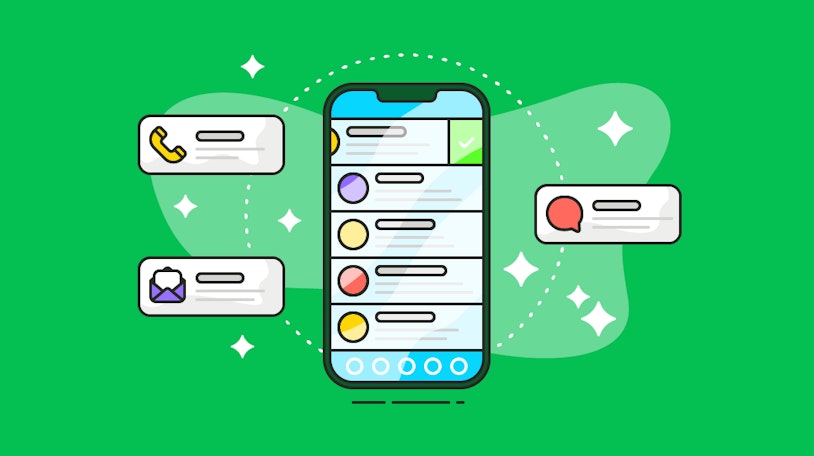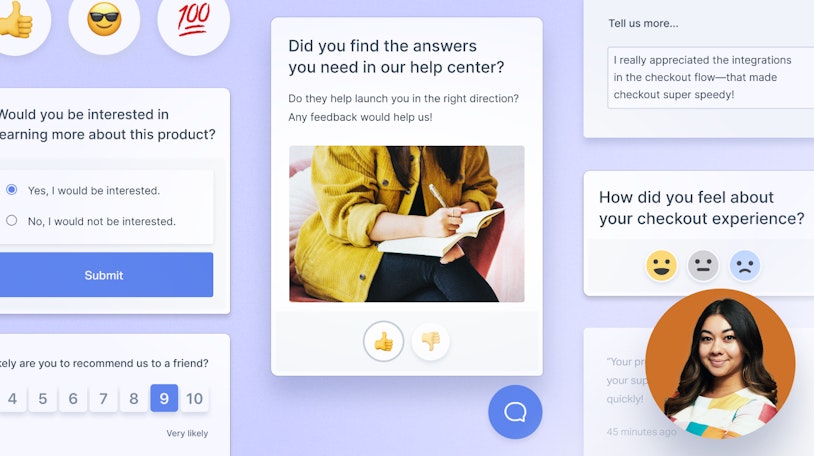Here’s a quick way to determine if you’re a customer-focused company: When making decisions, do you start by looking at your balance sheet or by looking at customer feedback? If you want to grow your business and keep your customers loyal, we suggest using customer-focused strategies to guide your choices.
Customer focus is a strategy that puts customers at the center of decision-making. The best thing about customer focus is that it doesn't require fancy tools or skills. It simply requires a dedication to listening to your customers' needs and delivering on them.
Instead of focusing on profits above all else, customer-focused businesses make decisions based on how those decisions impact customers. It's a long-term strategy that develops loyalty, builds trust, and creates a competitive advantage for your business as a byproduct.
This guide will show you how to build a business known for its commitment to its customers.
What is customer focus?
Customer focus is a strategy you build into your company's day-to-day function. It centers the experience and opinions of the customer in all business decision-making and processes.
For instance: Your support team wants to change how they handle processing refunds. A company with a strong customer focus strategy would consider how often the customer reaches out for refunds, how the process usually goes, and how they could make things easier.
A company with a lesser customer focus mindset would likely try to figure out how to minimize the number of refunds offered to lessen the impact on their bottom line.
Good customer focus prioritizes users over everything else. It acknowledges that while your business may make some decisions that cost a bit more money, you'll reap the benefits back in lifetime customer value and loyalty.
Why is customer focus important?
The rewards of customer focus are two-fold:
It’s engaging for your customers. Your customers want to be listened to. According to research by Salesforce, 62% of customers expect companies to adapt based on their actions, feedback, and behaviors. If you aren't listening, your customers will find someone who will.
It’s good for your business. You'll be more successful overall because of the numerous benefits that customer focus brings to your business. It's a substantial competitive advantage: Customer-centric companies are 60% more profitable than companies that do not make decisions with a customer focus.
Creating a customer focus strategy puts you in a better position to build relationships, help customers become successful, and adapt to changes in the market.
3 examples of transformational customer focus
When you build your company around your customers' needs, it shines a light on new opportunities. Whether those opportunities are simple (e.g., bundling certain features together) or complex (e.g., pivoting to an entirely different business model), understanding your customers will open doors for growth.
Here are three examples of companies that have embraced customer focus to grow their businesses.
1. Ecolab
Ecolab's CEO Douglas Baker Jr. says that listening to customers was the key to their transformation from a $12 billion market cap company in 2011 to $55 billion in 2019. The HBR article says, "The same customers who were buying its core products were also voicing concerns about access to clean water."
Developing a customer-focused strategy facilitated Ecolab growing its business exponentially. They also became more proud of their place in the world: "As our teams widened their awareness of global issues, our pride has been enhanced," Baker said.
2. Mogo
Mogo, a Canadian financial services company, realized that its customers were not happy. The wait times for their customer service channels were causing frustration, leading to angry comments on social media.
Mogo decided to take action because, as they said, "Making sure you're happy is super important to us. Like, lose-sleep-over-it important to us. So, we had to fix this."
Mogo strongly invested in their online chat platform to improve customers' access to their support team. They made chat available within the app, within the browser, and also on the desktop app. They also invested in Help Scout, using tools that recognized their customers, so customers never had to repeat themselves when contacting support.
3. Blue River Technology
Lee Redden was a student of the Lean LaunchPad when he came up with the idea for a company that designed large-scale riding lawn mowers. As part of the startup course, Redden went out and did customer development for this idea, talking to 15 customers a week.
Three weeks into the course, the entire company pivoted. Why? Because they uncovered the problems that customers actually wanted to solve. Blue River Technology has now received $13 million in funding to develop intelligent agriculture equipment that solves its target market's issues.
Redden says that the customer feedback they received was crucial in their success:
"The customers have way more insights than we had…they had been thinking about their own problems for so long. If you just go out and try to sell, maybe you'll find some buyers, maybe you won’t, but you won't be learning about what you should be doing."
There are many ways to aggregate customer feedback, but the best is through your interactions with customers. Net promoter score (NPS), customer satisfaction score (CSAT), customer health score (CHS), and customer effort score (CES) are all excellent ways to get a better feel for how your customers are doing.
How to improve customer focus at your company
Creating a customer-focused company is possible for any business, but it's not as straightforward as just declaring customer centricity. Chris McCormick, CEO of L.L. Bean, said: "Many people have fancy things to say about customer service, but it's just a day-in, day-out, ongoing, never-ending, persevering, compassionate kind of activity.”
To become genuinely customer focused, you need to be intentional about how you interact with your customers every day. Your company needs to center every interaction around the customers' best interests. As you expand, this gets harder and harder to scale.
The methods below will help you improve the customer focus strategy at your company, no matter the size or scope.
1. Shorten the distance between customers and employees
As your company grows, more distance forms between your customers and employees. When you're a team of one, you constantly talk to your customers. Early employees are extremely hands-on with customers through sales conversations or by helping them troubleshoot your software.
But as you grow, you might add employees who never spend time helping customers directly. Managers focus more on the business and their team members than on customers. The C-suite rarely talks to the average customer, only dealing with the biggest or most upset clients.
In some cases, employees might be many layers removed from what customers are actually saying. In those cases, it is essential to implement customer focus strategies that allow you to build stronger and deeper customer relationships.
Shrinking the distance between customers and employees means that everyone in the company is customer-facing. We suggest the following practices:
Consider implementing whole company support to get every employee talking to customers (after some training, of course!).
Create a customer-focused newsletter that shares customer stories, support tickets, reviews, and customer feedback with the entire company.
Send reviews and customer feedback into Slack channels where the entire company can see them and understand what customers love and hate about your product. For instance, use Help Scout's NPS functionality and Zapier to publish every new response to your whole company automatically!
Utilize fast-contact methods of providing customer service. Live chat, social media, and texting are all super quick ways to bridge the gap between your customers and the company. Having teams like sales and marketing monitor the chat on specific pages within your product is a great way to get more face time for typically non-customer-facing team members.
Dave Grow, president and COO at Lucidchart, has seen the benefits of being close to the customer echo across his career. He's read over 100,000 customer support tickets throughout his time at the company, noting that it's helped him maintain empathy for their customers. Be like Dave and find more ways to connect directly with your customers in your daily work.
2. Measure what matters
If you're rewarding team members for actions that aren't grounded in customer-centric thinking, you're not building a customer-focused company.
For example, the classic case of metrics gone wrong is the salesperson who crushes their sales goals and makes a ton of commissions selling to customers who only end up churning three months later. They're doing everything right when you look at their sales targets, so what's not working?
If you want your team to listen to the customer, you need to make customer focus a part of your key performance indicators. Consider using metrics like:
Customer satisfaction (CSAT — yes, even for your sales team!)
Net promoter score (NPS)
Lifetime value (LTV)
3. Lead by example
Everyone in the company will take their cues from you. Suppose you spend time bad-mouthing customers, focusing on cost-cutting metrics instead of customer satisfaction, and generally removing yourself from the customer experience. In that case, you can't expect the rest of your company to act in the customer's best interest.
Instead, show your entire company how vital the customer is to you and the business:
Learn how to vent about customers productively.
Spend time working with customers every week.
Read through your NPS responses regularly and respond to your customers.
Make it easy for your customers to get ahold of you with quick-moving channels like chat and social.
Treat your front-line employees with respect, including paying them what they deserve.
4. Build a feedback loop
Without a robust Voice of the Customer program, it's impossible to incorporate customer insight data into your decision-making process.
Asking customers what they think and then analyzing and acting on that insight is key to staying focused on the customer. After all, if you don't ask, how will you know what your customers need?
There are many ways to ask for customer feedback. Try implementing at least three in your business so customers are asked what they need at different times and over different channels. For example:
Ask customers who've received support how they feel about their service.
Use in-app feedback surveys to ask customers about new features or usability.
Follow up with customers who cancel and ask about why they churned.
Build signature-based NPS links into your company emails.
Once you have the feedback, make it centrally available to everyone in the company.
Understanding what the customer feels helps everyone (from marketing to sales to product) make better-informed decisions. Keeping the focus on your customers means responding to their feedback across the business.
5. Understand customer expectations
Many companies will start trying to build a customer focus strategy by assuming what they think their customers want and then building on it. For instance, they may know that their competitors have a lot of success with specific support channels or a product feature they don't currently offer.
Instead of building your strategy around what you assume your customers want, ask them. Use NPS and other information-gathering tools to understand their expectations and work toward that, rather than building a new strategy based on your assumptions of what your customers should want.
Building a customer-focused business
Jennifer Lee, managing partner at Deloitte, said, "The payoff, with a strategic, well-executed process, could be amazing: turning customers' ideas into real, tangible products can build incredible loyalty and engagement — two highly treasured commodities in a competitive marketplace."
At the beginning, your company was (hopefully) built on an idea that appealed to your target customer. You knew your first customers' needs, and you created something to address them.
But as companies grow, it can become challenging to stick to that same customer focus. By keeping the distance between customers and employees small, measuring what matters, being a customer advocate yourself, and constantly seeking feedback, you can get back to the basics: the customer.











